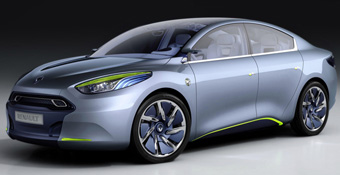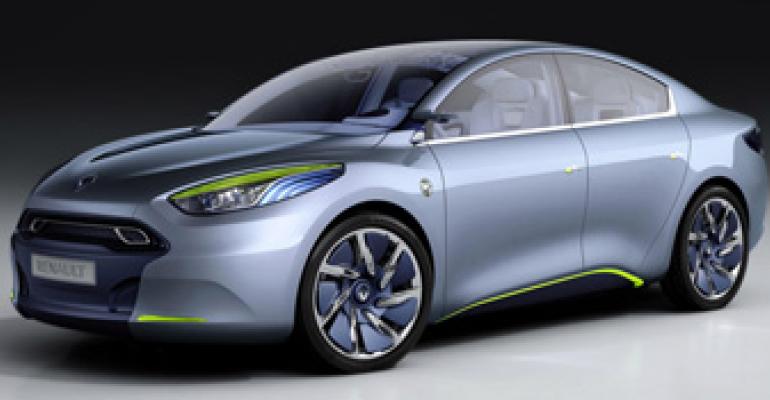
PARIS – Two years after presenting its plan for a range of four electric cars at the Frankfurt auto show, Renault is marketing them in France.
Renault and alliance partner Nissan have gambled about E4 billion ($5.6 billion) that they can be to electric cars what Toyota is to hybrids. French dealers are taking orders for the electrically converted Fluence ZE sedan and Kangoo ZE delivery van. Purpose-built Zoe and Twizy EVs launch next year.
A spokesman says Renault has 12,000 orders in Europe for its cars. The Le Figaro newspaper reports Renault also has an order for 15,900 Kangoo ZE vans, but Yves Capelle, who worked on the project, says the auto maker cannot confirm the report.
“We have received nothing official,” he says.
The Fluence ZE’s front end is at least 88 lbs. (40 kg) lighter than that of the 4-door Fluence, because the 70-kW (95-hp) synchronous motor weighs less than the lightest diesel. The rear end is 616 lbs. (280 kg) heavier with the 22-kWh lithium-ion battery located behind the rear seats. Modified suspension components handle the new weight distribution.
The Fluence ZE is 5.1 ins. (13 cm) longer than its diesel-powered counterpart, to accommodate the battery behind the back seat and still provide sufficient knee room for passengers. The Fluence ZE gets a grille treatment that recalls the smiling wide grilles featured on all new Renaults, but the ZE version’s taillights are unique.
The Kangoo ZE gets no external changes beyond badging and a logo, and it even keeps its fuel tank flap, because versions sold in cold countries will have the option of a fuel-fired heater.
The Kangoo battery is packaged under the floor, and the 1,430-lb. (650-kg) payload is the same as that of the internal-combustion versions.

The Fluence got its start in Israel, when Renault CEO Carlos Ghosn met Shai Agassi of EV infrastructure developer Better Place, who sought an auto maker to make the vehicles there. Israel agreed to reduce taxes on EVs, Nissan engineers developed an adequate battery and Renault agreed to be a pioneer.
Needs of the Israeli market determined some of the Fluence’s tuning. Israelis commonly drive with automatic transmissions, so the electric motor of the Fluence is tuned to have the same small “creeper” acceleration when the driver takes his foot off the brake. The Kangoo, which nearly always is driven in Europe with a manual transmission, sits still if the foot is off the brake but not pushing the accelerator.
Agassi, who is investing millions to build recharging infrastructure in Israel, also is responsible for two features unique to the Fluence. He believes quick changes of the battery are essential to EVs’ future, so the Fluence has a battery that is packaged vertically and can be removed and replaced in a special service station in three minutes – as fast or faster than a liquid-fuel fill-up.
Only Israel, Denmark and Australia currently are planning a network of quick-change stations.
The Fluence has a charging port on each front fender. That is because in Israel, charging posts have two cables so that two cars can be charged at once, on the right fender of one and the left fender of the other.
Better Place has ordered 100,000 Fluences.
Except in countries with a Better Place presence, Renault expects only 20% of Fluence ZEs to be purchased by individuals. The auto maker thinks the Kangoo ZE, which is aimed at businesses, probably will get 30% individual buyers, mainly artisans and craftsmen, with the rest going to fleets such as those of the French post office and national electric company.
The Kangoo and Fluence use the same electric motor supplied by Continental, providing 167 lb.-ft. (226 Nm) of torque.
Power output in the Fluence is 70 kW (95 hp) but is limited in the Kangoo to 44 kW (60 hp). The motor is a synchronous design using a rotor coil.
Laurent Forun-Crouvoisier, who directed work on the electric powertrain, says such a motor is more difficult to engineer into the vehicle, but is cheaper and more efficient than a permanent-magnet motor. But he adds that while the coming Zoe will use the rotor coil, the scooter-like Twizy will get a motor with permanent magnets because they can be more compact.
The Fluence ZE and Kangoo ZE use batteries from Nissan’s joint venture with NEC in Japan. The Kangoo’s battery is the same as that used by the Nissan Leaf, but with different mechanical packages.
The Kangoo is built in Maubauge, France. The Fluence uses cells from the JV, but the battery is assembled at the Oyak-Renault plant in Bursa, Turkey, where the Fluence and Fluence ZE are assembled. Capacity is 30,000 annually.
Goodyear developed tires for the Fluence while Michelin did the same for the Kangoo. Each EV has a TomTom navigation system featuring a map showing a circle around the present location to indicate how much battery power is left. In some countries, the maps also show public charging points.
Both the Fluence and the Kangoo, which is expected to be used in city delivery service, feature an optional “horn” that automatically emits a mild warning sound to alert pedestrians. The sound can’t be heard inside the cabin, so only tire and wind noise are audible.
At 186.9 ins. (474.8 cm), the Fluence is the largest EV proposed for production by any auto maker over the next several years. Spokesmen say Renault above all wants to assure customers that while it is electric, it is a real car. The instrument panel includes a gauge indicating how much charge is left, instead of how much fuel is left.
A small display shows whether the battery is charging or discharging, and a 1-color digital readout connected to the car’s computer provides information including present consumption of kilowatts, average speed and average consumption per kilometer.
The Fluence ZE is meant to be price-competitive with the diesel-powered version. The EV’s base price is E26,900 ($35,740), or E27,900 ($37,000) for a higher trim level. The battery rents for E82 ($109) a month, and a suggested home-charging station from other providers costs E800 ($1,060).
The Kangoo base price ranges from E17,900 to E20,300 ($23,800 to $26,980) for different seat configurations and sizes, with a similar battery-rental charge.
On the savings side, Renault EV buyers get a E5,000 ($6,650) bonus from the French government, insurance is said to be 20% cheaper and electricity will cost only about E1.08 ($1.44) per 62 miles (100 km) compared with diesel fuel at about E7.00 ($9.32) per 62 miles (100 km).
Renault says that in total, an EV costs less to operate than an ICE-powered vehicle if driven about 12,400 miles (20,000 km) a year, or 50 miles (80 km) a day for 250 days.
The auto maker says this makes the Fluence attractive to people making regular workday commutes but is not a city car, which often sees less daily use.
Renault marketers, meanwhile, are working hard to reduce public perceptions of the risks of EV ownership. The auto maker offers a 25% discount on rentals to persons wanting to take a long trip; the powertrain is guaranteed for five years; and the vehicle guarantee is for three years or 62,000 miles (100,000 km).
Battery rental includes breakdown assistance. Owners can check on the state of their car using a My ZE Connect application on their smartphone or home computer.
All 400 French dealers can sell Fluence ZE models, 127 experts have been trained to repair them and 204 ZE centers have been set up to demonstrate them to the public.
“We wanted the Fluence to be something people want,” says Capelle. “A real car, and it’s electric.”
Kangoo ZE deliveries begin this month in France, with the Fluence ZE arriving in mid-November. Better Place in Israel also will get the EVs in November, with other countries to follow.
With fleet buyers as its target audience, Renault is promoting its Fleet Asset Management service already offered for conventional vehicles. Starting at E5 ($6.64) per vehicle per month, fleet managers can receive daily uploads from each unit telling how much it ran, how much energy was used and what might be going wrong.
Renault and Nissan have signed more than over 100 agreements with cities and regions to develop public recharging structure, but the work is progressing slowly.
Renault says Europe will have 16,700 charging points by the end of the year, including 2,000 in France and 3,700 in Germany. By the end of 2012, Renault expects the total in Europe to be 50,000, including 10,000 in France.




